What Is Single Origin Anyway?
Posted by Barrett the Bearista on 31st Dec 1969
Ever had a cup of coffee you just didn’t like? Maybe it was a bag of Brazil, so you thought to never get Brazilian coffee again! Before you make that choice, let me help you out with what gives a coffee its flavor. The region a coffee is grown in certainly contributes to its flavor, but let’s dig a little deeper!
In a single origin coffee, the specific territory it is grown should be listed, such as our Costa Rica La Minita Tarrazu. In this example, even the farm that it is grown on is listed. While not all farms are large enough to produce the crop to be exclusively distinguished, they will be linked to the specific region- excluding lower quality beans that may be mixed in with whatever else is grown in the country. The soils, climate and sun exposure (shade grown is often sought after) will determine the traits the crop will have.
Another trait to look for is the variety of the bean. Essentially all “good” coffee will be of the Arabica Family. Specialty coffee roasters will often note the variety of the bean as well. Popular varieties that we offer are Bourbon, Typica, Caturra, and Catucai. There are large efforts underway to produce delicious robusta coffees since they can withstand the rising temperatures more effectively than Arabica. Robusta coffee also has nearly double the caffeine content of Arabica.
Once the bean is Grown and harvested, it will need to be processed and dried. The fruit is known as coffee cherries, and the way it is cleaned makes another flavor impact. Washed, natural and honey are the most common methods. Most of the coffee we offer is washed, however our new Brazil offerings are natural process- and while some natural process methods have left a tart note I did not care for, this Brazil has become one of my favorites overall. The Washed method has all the fruit cleaned off first, then the bean is allowed to dry. This leaves you with a smooth bodied cup of coffee. The natural method allows the bean to dry with the fruit on it which results in a heavy bodied flavor. Honey process is the third most common process method, and unfortunately it doesn’t involve any actual honey. Lol. In this method the beans have the inner fruit removed by placing the coffee cherries in a centrifuge and removing the inner fruit. The coffee is then allowed to dry. This coffee tends to have a wild sweetness associated with it.
Elevation is the final pre-roast contributor to flavor. 2000 meters (6000 feet) tends to be the high end of commonly available coffee. The plant will grow slower at these elevations, and not be as productive. However, these are often more sought after, and are often labeled SHG (strictly high grown), or SHB (strictly hard bean). They will be more flavorful than lower grown coffee, much like peppers grown in a dry climate will be spicier than those grown in a wet climate.
To no surprise, roasting has the biggest impact of what your coffee will taste like. Some roasters specialize in lighter roast coffee, especially “third wave” roasters, while others cater to customers who favor medium or dark coffee. Lighter coffee will have more fruity flavors however will be considered sour to many people, while darker roasted coffee brings out the caramelized sweetness or chocolate notes of your brew- however to those who favor light roast may consider dark roast to be bitter.
Finally, the last trek of the coffee to you- freshness. Coffee loses its flavor FAST- especially it you are purchasing it pre-ground. Darker roasted coffee will lose its flavor even faster. We recommend our coffee to be used within 4 weeks for peak flavor.
A very light roast coffee can use a little time to rest before it is used to reach peak flavor. This rest period can be 2 days to a couple weeks, while a medium dark will be ready to drink the day after roasting.
So, while you travel the world of flavor, when you snag a bag of coffee that you love, grab those details! If it’s a perfect batch of Columbia, check and see what part of the country, what the elevation is, and how it was processed!

